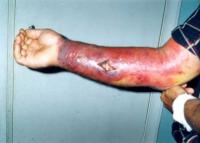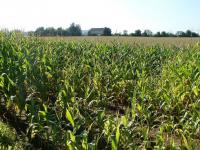-
Bolstering international response capabilities to infectious disease threats
To make the world safer against future infectious disease threats, national health systems should be strengthened, the World Health Organization’s emergency and outbreak response activities should be consolidated and bolstered, and research and development should be enhanced, experts say
-
-
How will the next leader of WHO tackle future health emergencies?
In light of heavy criticism of the World Health Organization’s handling of the Ebola outbreak, the election process for the next director general will be under intense scrutiny. Experts outline the key questions on epidemic preparedness for prospective candidates.
-
-
House temporarily halts sale of Plum Island
New York and Connecticut lawmakers who have been campaigning against the sale of Plum Island by the federal government, have won an impressive victory as the U.S. House of Representatives voted unanimously on Monday to halt efforts to sell the property, at least temporarily. Plum Island, located of the north-eastern tip of Long Island, has for decades housed a high-security biolab in which research into deadly animal diseases pathogens. The aging lab is closing, and its operations will be moved to a modern high-security lab being built in the campus of Kansas State University.
-
-
Senate approves $1.1 billion to fight Zika virus
The Senate on Tuesday voted 68-29 to allocate $1.1 billion in emergency funding to fight the Zia virus threat. The funds fall short of the White House’s request of $1.9 billion, but are significantly more than House Republicans’ $622 million anti-Zika proposal. The House will debate the measure on Wednesday.
-
-
Maryland identifies health vulnerabilities resulting from climate change
As world leaders convened in Washington, D.C. a couple of weeks ago for the Climate Action 2016 summit, a new report by Maryland public health leaders details the impacts of climate change on the health of Marylanders now and in the future. The report examines the relationship between exposure to extreme weather events and risk of selected health outcomes including food and waterborne illnesses, hospitalization for heart attacks and asthma, and motor vehicle accidents.
-
-
NSF awards $1.7 million in rapid response grants to study Zika virus
Zika, discovered in Uganda in 1947, has been documented since the 1950s along the equatorial belt from Africa to Asia. In 2014, the virus spread eastward to French Polynesia, and in 2015 to Mexico, Central America, the Caribbean (including Puerto Rico) and South America, where the outbreak continues. To find new ways of halting the spread of Zika — fast becoming a major public health threat — the National Science Foundation (NSF) Division of Environmental Biology’s Ecology and Evolution of Infectious Diseases (EEID) Program has funded nine rapid response, or RAPID, grants totaling $1.7 million.
-
-
A new paper-based test for the Zika virus
A new paper-based test developed at MIT and other institutions can diagnose Zika virus infection within a few hours. The test, which distinguishes Zika from the very similar dengue virus, can be stored at room temperature and read with a simple electronic reader, making it potentially practical for widespread use.
-
-
Israeli tech ready to take on Zika-carrying mosquito
The mosquito-borne Zika virus, according to new reports, is even more dangerous than first believed. While better information about prevention has helped slow the rate of infection in some areas, the health community is still urgently searching for a vaccine or drug treatment. The world seeks a medical intervention, but Biofeed’s no-spray green product targets the insects directly.
-
-
Developing new anthrax vaccine

The Texas A&M Center for Innovation in Advanced Development and Manufacturing (CIADM) will produce an intranasal anthrax vaccine candidate under a task order issued by the U.S. Department of Health and Human Services (HHS). This is the first task order issued to the Texas A&M center and will enhance protection from anthrax disease. The Texas A&M facility is one of three CIADMs — and the only academically-based center — established as public-private partnerships with BARDA in 2012 to enhance the nation’s emergency preparedness against emerging infectious diseases.
-
-
Growing demand for bioenergy threatens global food supply

As countries around the world look for ways to reduce their use of fossil fuels, the growing demand for bioenergy runs the risk of threatening the global food supply. Researchers have developed a certification scheme for biomass resources designed to incorporate food security, to help ensure people in affected regions of the world can continue to put food on their tables.
-
-
Yellow fever epidemic threatens new global health emergency
Evidence is mounting that the current outbreak of yellow fever is becoming the latest global health emergency, two experts say, calling on the World Health Organization (WHO) to convene an emergency committee under the International Health Regulations. In addition, with frequent emerging epidemics, they call for the creation of a “standing emergency committee” to be prepared for future health emergencies. The add that vaccine “supply shortages could spark a health security crisis.”
-
-
The long history of lead poisoning in the U.S.
While state and federal officials continue to criticize each other for failing to guarantee safe drinking water, the question of exactly who is responsible for crises like in Flint, Michigan, lies at the root of the problem. “The crisis in Flint brought the true costs of a neglected infrastructure to the nation’s attention, but in the finger-pointing there are deeper debates over public and private responsibility and the impact of dysfunctional politics on public health,” says one expert.
-
-
Floods, coastal erosion may expose contents of UK landfills
The contents of historic coastal landfill sites in England and Wales could pose a significant environmental threat if they erode, according to a new study. The main risks to these landfills come from the effects of climate change, including erosion and flooding with salt water from storm surges and higher water levels.
-
-
Addressing global food system challenges
Agriculture now produces more than enough calories to meet basic human dietary needs worldwide. Despite this seeming abundance, one out of eight people do not have access to sufficient food. A new study presents a set of strategies to address these complex challenges of producing food for a growing global population, while reducing environmental impacts and increasing resilience in the face of climate change.
-
-
Mapping water use of America’s water resources
Water is one of our nation’s most important natural resources, one that is long been considered inexhaustible. Yet changes in land use, climate, and population demographics are placing unprecedented demands on America’s water supplies. As droughts rage and aquifers dwindle, people may wonder: Is there enough water to meet all our needs?
-
More headlines
The long view
What We’ve Learned from Survivors of the Atomic Bombs
Q&A with Dr. Preetha Rajaraman, New Vice Chair for the Radiation Effects Research Foundation in Hiroshima and Nagasaki, Japan.
Combatting the Measles Threat Means Examining the Reasons for Declining Vaccination Rates
Measles was supposedly eradicated in Canada more than a quarter century ago. But today, measles is surging. The cause of this resurgence is declining vaccination rates.
Social Networks Are Not Effective at Mobilizing Vaccination Uptake
The persuasive power of social networks is immense, but not limitless. Vaccine preferences, based on the COVID experience in the United States, proved quite insensitive to persuasion, even through friendship networks.
Vaccine Integrity Project Says New FDA Rules on COVID-19 Vaccines Show Lack of Consensus, Clarity
Sidestepping both the FDA’s own Vaccines and Related Biological Products Advisory Committee and the CDC’s Advisory Committee on Immunization Practices (ACIP), two Trump-appointed FDA leaders penned an opinion piece in the New England Journal of Medicine to announce new, more restrictive, COVID-19 vaccine recommendations. Critics say that not seeking broad input into the new policy, which would help FDA to understand its implications, feasibility, and the potential for unintended consequences, amounts to policy by proclamation.
Are We Ready for a ‘DeepSeek for Bioweapons’?
Anthropic’s Claude 4 is a warning sign: AI that can help build bioweapons is coming, and could be widely available soon. Steven Adler writes that we need to be prepared for the consequences: “like a freely downloadable ‘DeepSeek for bioweapons,’ available across the internet, loadable to the computer of any amateur scientist who wishes to cause mass harm. With Anthropic’s Claude Opus 4 having finally triggered this level of safety risk, the clock is now ticking.”
“Tulsi Gabbard as US Intelligence Chief Would Undermine Efforts Against the Spread of Chemical and Biological Weapons”: Expert
The Senate, along party lines, last week confirmed Tulsi Gabbard as Director of National intelligence. One expert on biological and chemical weapons says that Gabbard’s “longstanding history of parroting Russian propaganda talking points, unfounded claims about Syria’s use of chemical weapons, and conspiracy theories all in efforts to undermine the quality of the community she now leads” make her confirmation a “national security malpractice.”
